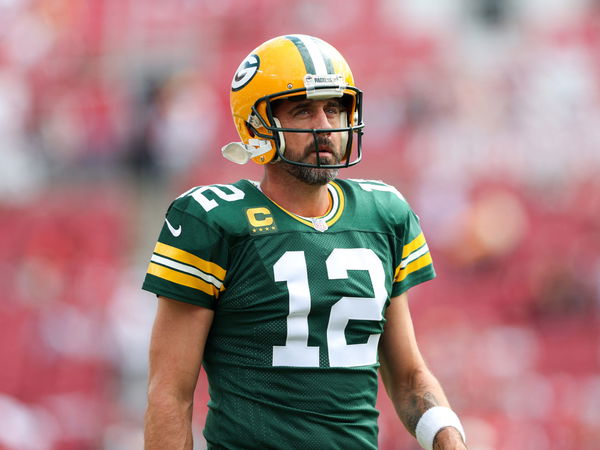
USA Today via Reuters
Green Bay Packers quarterback Aaron Rodgers (12) looks on. Mandatory Credit: Nathan Ray Seebeck-USA TODAY Sports | Reuters

USA Today via Reuters
Green Bay Packers quarterback Aaron Rodgers (12) looks on. Mandatory Credit: Nathan Ray Seebeck-USA TODAY Sports | Reuters
On September 8, 2008, when Aaron Rodgers was just 3 hours from making his NFL debut, a Minnesota visitor spotted a Packers fan wearing the No.12 jersey. Until then, it was like Rodgers lived in the shadow of Brett Favre. For many, he still did, despite Favre’s bitter falling out with the team’s management after the 2007 season and his subsequent “retirement.” The Packers fan said, “This jersey isn’t about a player’s contribution to the team. Wearing this jersey is a statement.” And a statement is what Rodgers made that day.
As Lambeau Field buzzed with chants of “We want Favre,” Aaron Rodgers completed a couple of important passes, which led to him scoring his first touchdown on a game-clinching sneak from the one-yard line. He spiked the ball, ran to the stands, and made his first Lambeau Leap–in the same end zone where the “We want Favre” chants were coming from. Who knew that would be the first of many? And who knew that would be the start of a Packers legacy that few others have rivaled?
So when NFL Throwback revealed the Green Bay Packers Mount Rushmore featuring Brett Favre, Bart Starr, and Don Hutson, how could they not have included the quarterback who led them to a Super Bowl championship in 2011? Remember that record-setting season with a 122.5 passer rating, highly regarded as one of the greatest quarterback seasons in history? But you had to know it was coming, considering how he stepped up after Favre’s departure.
ADVERTISEMENT
Article continues below this ad
Passing for 4,038 yards and 28 touchdowns in 2008, the team showed its inclination to retain him with a 6-year contract extension. And he lived up to expectations. In 2009, he became the only player to post consecutive 4,000-yard passing campaigns in his first two seasons as a starter after throwing for 4,434 yards and 30 touchdowns. That year, he recorded a passer rating of 103.2, only second to Bart Starr’s 105.0 from 1966.

USA Today via Reuters
Sep 25, 2022; Tampa, Florida, USA; Green Bay Packers quarterback Aaron Rodgers (12) reacts on a touchdown scored against the Tampa Bay Buccaneers during the first quarter at Raymond James Stadium. Mandatory Credit: Kim Klement-USA TODAY Sports
NFL Throwback’s video aptly captured Rodgers’ skills: “You don’t earn the moniker of Title Town without serious difference makers at quarterback. Green Bay’s Mount Rushmore begins with Aaron Rodgers, one of the most skilled throwers in the league!” The 40-year-old has the most passing touchdowns in Packers history (475), and one of the most memorable games he played was Super Bowl XLV. Throwing for 304 yards and 3 touchdowns, and with a passer rating of 111.5, not only did he lead Green Bay to a championship but also earned the Super Bowl’s MVP award.
Following that Super Bowl ring with the remarkable season that was 2011, he won the NFL MVP award that year. And who can forget his 2014 victory over the Bears with 4 touchdowns, earning him the Offensive Player of the Week? Boy, was he great! Capping off his 18-season tenure with Green Bay in 2022, Aaron Rodgers threw for 59,055 yards and 475 touchdowns in 230 games, with a passer rating of 103.6. And well, the same can’t be said about his time with the New York Jets.
Making his debut for the team last year, he suffered a season-ending Achilles injury. Having been on the road to recovery since then, Rodgers missed last month’s mandatory pre-season mini-camp, with head coach Robert Saleh calling it an “unexcused” absence. While no one knew where exactly the quarterback was, turns out he’d gone to Egypt, emerging from the shadows at UFC 303 in Las Vegas. That said, before Rodgers made his mark in Green Bay, his predecessor, Brett Favre–who also went from the Packers to the Jets–cemented his name in Lambeau Field history.
Favre’s gunslinger spirit was GOAT-like. In the 1990s, his throws defied logic and physics. His arrival in Green Bay in 1992, along with head coach Mike Holmgren, was a welcome change after a couple of forgettable decades in Packers history. On the eve of his Pro Football Hall of Fame induction, the former quarterback said, “There’s no doubt that the best head coach, the greatest head coach I ever played for, was Mike Holmgren.” And with a storied career like his, you would think Favre didn’t have any regrets, right? But he did.

“My only regret – and it’s really not a regret – is that [Holmgren and I] didn’t play together longer.” From 1992 to 1998, they reached 2 Super Bowls (in 1997, where he led the Packers to a 35-21 victory over the Patriots, and in 1998, where they lost to the Broncos). While Holmgren left the team, Brett Favre saw out his tenure in 2008, having started every game from September 20, 1992, to January 20, 2008–a 253-game streak.
His passer rating of 85.8, having thrown for 61,655 yards and 442 touchdowns in 255 games, and his 3 straight MVP titles (1995, 1996, 1997) are proof of just how dominant he was. Favre’s numbers were top-notch, but his heart for the game is what made him a Packers legend. But who walked before Brett Favre could run? It was quarterback Bart Starr, the master of poise, who is next on the list. Known as ‘The Iceman’ for how well he handled pressure, Starr led the team to their first two Super Bowl titles (1966 and 1967).
The quarterback joined the Packers in 1956, and 3 years later, in came head coach Vince Lombardi, whose greatness speaks for itself. Five NFL Championships in seven years, including the first two Super Bowls, and a trophy named in his honor. Through 1967, the Packers went 73-21-4 in the regular season and 9-1 in the postseason in games that Bart Starr started. And for Lombardi, Starr was “the smartest quarterback I ever saw.” The Ice Bowl. 21-17 win. Game-winning touchdown run with 13 seconds left, clinching a 3rd straight NFL Championship. That’s all you need to know about Bart Starr’s legacy in Green Bay.
But quarterbacks don’t win titles alone. They need dependable targets, and that’s where Don Hutson comes in. Hutson redefined wide receivers in the 1930s and 1940s before Randy Moss and Jerry Rice ruled. Hutson’s dominance forced double covers, racking up a then-record 99 career touchdowns. No wonder he led the Packers to three NFL titles.
From Rodgers’ pinpoint accuracy to Favre’s ice-cold clutch, Starr, with ice in his veins, and the ever-threatening Hutson have rightfully earned their spot in Lambeau Field’s Mount Rushmore. That said, there are a few more who deserve to be remembered, though.
ADVERTISEMENT
Article continues below this ad
The Legend of Lambeau: Celebrating the Green Bay Greats
Green Bay’s glory goes deeper than what meets the eye. Sure, they have their modern figures, but the Packers’ legacy is built on bricks of strength, not just MVP trophies. ‘Mechanic’ Forrest Gregg, anchoring the offensive line under the guidance of Lombardi himself. Think about it: seven-time All-Pro, Lombardi’s “finest lineman,” and a key cog in football’s greatest dynasty. Gregg’s relentless hustle paved the way for Packers touchdowns.
On defense, linebacker Ray Nitschke was the beating heart. This middle linebacker wasn’t just a tackler–he was the reason Green Bay won five NFL titles and the first two Super Bowls. A Hall of Famer and ultimate game-changer, Nitschke instilled fear in opposing quarterbacks with his disruptive play and clutch fumble recoveries.
ADVERTISEMENT
Article continues below this ad
Finally, defense-pro Reggie White, who earned two-time NFL Defensive Player of the Year, alongside 13 consecutive Pro Bowls and 13 All-Pro selections. While he spent his greatest years with the Eagles, his six-year Packers career made him the team’s all-time sack leader (securing the Super Bowl XXXI).
Next time you hear someone say “Green Bay Packers,” remember the foundation. These are the gridiron greats whose pursuit cemented Green Bay’s place in football history.
ADVERTISEMENT
ADVERTISEMENT
ADVERTISEMENT
ADVERTISEMENT

